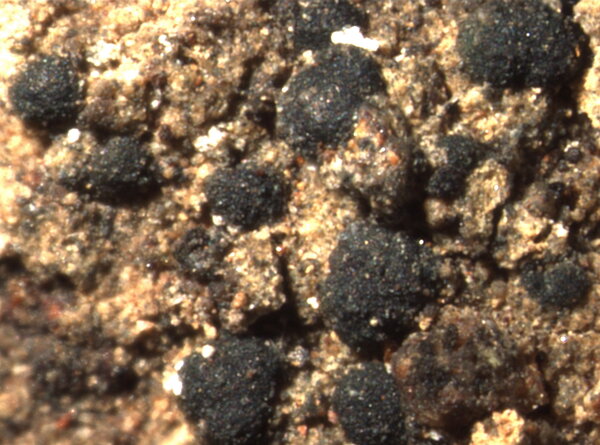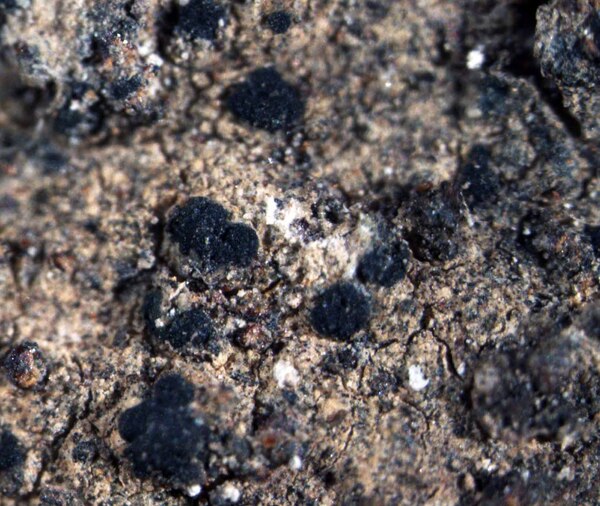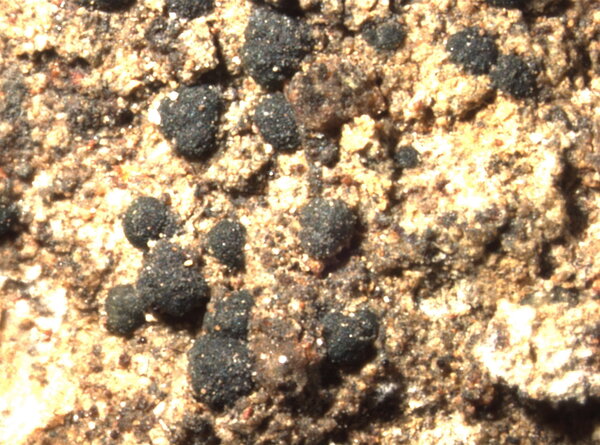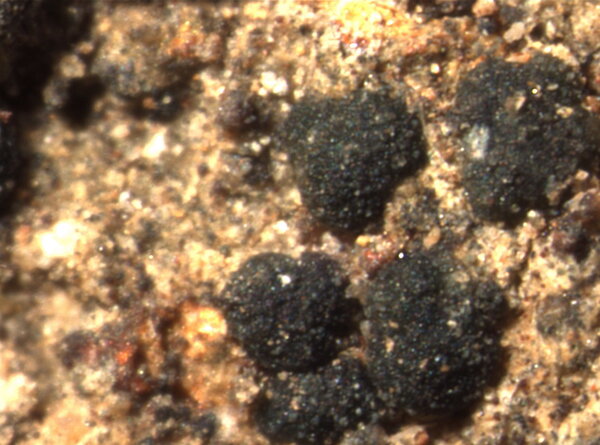Brianaria bauschiana (Körb.) S. Ekman & M. Svenss.
Lichenologist, 46: 292, 2014. Basionym: Biatora bauschiana Körb. - Parerga Lichenol.: 157, 1860.
Synonyms: Biatora rusticella (Nyl.) Walt. Watson; Biatora semipallens (Nyl.) Walt. Watson; Catillaria microspora Maslowa; Lecidea bauschiana (Körb.) Lettau; Lecidea dilutiuscula Nyl.; Lecidea infidula Nyl.; Lecidea lynceola Th. Fr.; Lecidea rusticella Nyl.; Lecidea semipallens Nyl.; Lecidea sylvicola var. infidula (Nyl.) Leight.; Micarea bauschiana (Körb.) V. Wirth & Vězda
Distribution: N - Ven (Nascimbene & al. 2005b), TAA, Lomb (UPS-L-166809), Lig. S - Cal (Puntillo 1995, 1996).
Description: Thallus crustose, grey, grey-green, grey brown or sometimes rust-coloured, thinly episubstratic, continuous, minutely cracked or granulose. Apothecia micareoid, sessile, not constricted at base, to 0.3 mm across, sometimes confluent and forming up to 0.8 mm wide, tuberculate aggregates, with a convex-hemispherical, pale bluish grey to brown-black disc (brown in shade-forms), from the beginning without a distinct proper margin. Proper exciple absent; epithecium colourless or greenish, K-, N+ red; hymenium colourless, greenish or pale blue-green, 30-65 μm high; paraphyses scarce, of two types: the majority sparingly branched and 0.5-1.5 μm thick, the others simple, often fasciculate, and 1.5-2 μm thick; hypothecium colourless to pale greenish in upper part, of interwoven hyphae. Asci 8-spored, cylindrical-clavate, the I+ blue tholus with a wide, I+ dark blue tube structure that expands towards the top, without a pale axial body, Psora-type. Ascospores 1-celled, hyaline, ellipsoid, thin-walled, 6.5-10.5 x 2-4 µm. Pycnidia to 0.08 mm across, immersed, the wall greenish, K-, N+ reddish. Conidia bacilliform, 4-6 x 0.8-1 μm. Photobiont chlorococcoid, thin-walled, the cells globose and 5-12 µm wide, or ellipsoid and up to 15 x 10 µm. Spot tests: K-, C-, KC-, P-, UV-. Chemistry: thallus without lichen substances.Note: on a wide variety of substrata (rocks, exposed roots, consolidated soil) in shaded-dry situations (e.g. under overhangs), but restricted to humid areas. Probably overlooked and more widespread, especially in the Alps.
Growth form: Crustose
Substrata: rocks, bark, soil, terricolous mosses, and plant debris
Photobiont: green algae other than Trentepohlia
Reproductive strategy: mainly sexual
Most common in areas with a humid-warm climate (e.g. most of Tyrrenian Italy)
In underhangs rarely wetted by rain
Commonnes-rarity: (info)
Alpine belt: absent
Subalpine belt: absent
Oromediterranean belt: absent
Montane belt: rare
Submediterranean belt: very rare
Padanian area: absent
Humid submediterranean belt: absent
Humid mediterranean belt: absent
Dry mediterranean belt: absent

Predictive model
Herbarium samples
Growth form: Crustose
Substrata: rocks, bark, soil, terricolous mosses, and plant debris
Photobiont: green algae other than Trentepohlia
Reproductive strategy: mainly sexual
Most common in areas with a humid-warm climate (e.g. most of Tyrrenian Italy)
In underhangs rarely wetted by rain
Commonnes-rarity: (info)
Alpine belt: absent
Subalpine belt: absent
Oromediterranean belt: absent
Montane belt: rare
Submediterranean belt: very rare
Padanian area: absent
Humid submediterranean belt: absent
Humid mediterranean belt: absent
Dry mediterranean belt: absent

Predictive model
| Herbarium samples |
 Index Fungorum
Index Fungorum
 GBIF
GBIF








